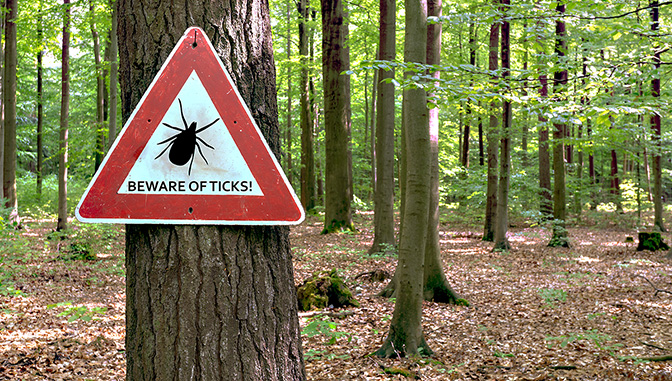Once Bitten, Twice Shy – Lyme Disease

When I was told I had Lyme disease, the first question I had was, “Why me?” After all, I’m not the outdoors type; I don’t hike, camp, or anything like that. How did a tick find me? What I soon came to realize is that there were two important factors that made me vulnerable to falling prey to a tick. One was my lack of knowledge about staying safe outdoors. Because I don’t spend a lot of time outdoors, I didn’t pay attention to the serious threat of tick-borne diseases or how to prevent them. The second big factor, unknown to me, was that I had moved to a high-density tick zone in the northeastern United States. I want to share with you three questions that, if I had known their answers, may have prevented me from living with the consequences of a tick-borne disease.
- How do ticks hunt for prey? Ticks live in wood and leaf piles, high grass, on low-hanging branches, and in shrubs. Unknowing hosts transport them to different locations. Ticks feed on the blood of both warm-blooded and cold-blooded mammals. They sense exhaled carbon dioxide to target their prey. Most ticks are passive hunters, waiting and watching for prey to pass by and then extending a hooked front leg to latch on. They do not jump, fly, or drop down from trees. Once they latch on, they crawl higher up on the body to where skin is thinner and easier to feed, particularly around the head and neck. Other typical places to attach are the groin, armpits, and other places they can easily hide.
- Do ticks live in my neighborhood? The short answer is yes. Ticks can and do live everywhere in the contiguous United States and Hawaii. Different kinds of ticks bearing different strains of infection live in various parts of the country. The major infections include Lyme, anaplasmosis, babesiosis, ehrlichiosis, and Rocky Mountain Spotted Fever. A brochure from the Centers for Disease Control and Prevention gives a snapshot of which ticks can be found in your region and the diseases they carry.
- Can I get a tick–borne disease from my pet? Yes! Pets can bring ticks into your home, which can latch on to you and your family. Your pets can also be infected with a tick-borne disease and require treatment. The Companion Animal Parasite Council provides interactive maps for tickborne illnesses, guidelines for keeping pets and their owners safe, and resources for veterinarians and pet owners.
Once bitten by the tick, my lack of information led me to do all the wrong things. I improperly removed the tick, and I didn’t recognize the symptoms. Consequently, I did not provide my physician with enough information, so I was repeatedly misdiagnosed. This phenomenon is very common with tick-borne illnesses such as Lyme.
The CDC provides all the information you need to avoid making these mistakes. With tick-borne diseases on the rise and new infections being discovered, it is important to be tick-aware. Prevention is the best way to protect your family and pets, but if you are infected, taking the right actions is imperative to get immediate and appropriate treatment and avoid potential long-term suffering.
Here are two helpful resources so that you are armed with the information you need to stay safe:
- Centers for Disease Control and Prevention: Prevent Lyme Disease – A good place to start for general information.
- Centers for Disease Control and Prevention: Ticks – Many resources including educational pamphlets for campers and hunters, videos for healthcare practitioners, and links to pages specifically addressing prevention, tick removal, diagnosis, and treatment for the major tickborne diseases.
Disclaimer: The views expressed here are solely those of the author(s) and do not necessarily represent or reflect the views of Excelsior College, its trustees, officers, or employees.



